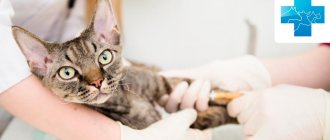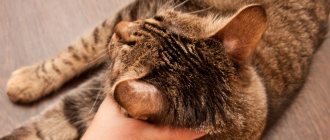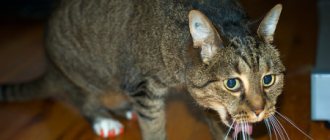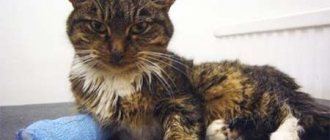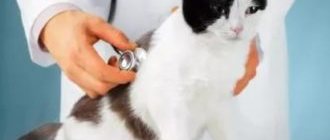Home » Cats » Cat diseases, symptoms and treatment, signs of disease » Causes and symptoms of epilepsy in cats
The causes of epilepsy in cats vary. In general, determining the root cause is very difficult, and sometimes impossible.
Epilepsy attacks are divided into two categories:
- congenital;
- false (acquired).
Epilepsy in cats, which is caused by a congenital disease, is caused by the following factors:
- Disorders of the development and functioning of the nervous system.
- Mating of closely related individuals.
- Infections during gestation of kittens.
- Hormonal imbalances.
- Diseases of the endocrine system.
- Hereditary factors (transmitted from parents to kittens).
Acquired epilepsy is caused in a healthy animal by the following actions:
- Trauma to the skull and brain.
- Changes in the brain due to neoplasms.
- Infections caused by viruses.
- Lack of vitamin B and vitamin D.
- Lack of calcium and magnesium in the diet.
- Intoxication of the body caused by drugs and chemicals.
- Presence of parasites.
Symptoms of epilepsy are divided into 2 types: symptoms during minor seizures and symptoms during major seizures.
The first case is characterized by the following features:
- Lack of concentrated gaze.
- Shifting pupils of the eyes.
- Increased salivation.
- Frequent vocal sounds.
- Involuntary movement of the head and limbs.
- Involuntary twitching of the body and limbs during sleep.
- Catching non-existent flies.
These symptoms last no more than one minute and do not interfere with the animal’s movement.
Symptoms of grand mal seizures:
- Aggressive or depressed state of the cat.
- Difficulty breathing, accompanied by wheezing.
- Foamy salivation.
- Cardiopalmus.
- Emptying the bladder and bowels.
- Convulsive movement of the limbs and jaw.
- Loss of consciousness and breathing.
- Pupil dilation.
- Raising fur.
This attack can last for five minutes. During these seizures, the animal loses the ability to move. After one hour, the cat returns to normal.
If the attacks are repeated many times and the animal is unconscious, then this condition is called status epilepticus, in which the animal may die.
Description of the disease
Epilepsy in animals is similar to a similar disease in humans.
It appears suddenly: the cat, for no apparent reason, begins to worry, walk or run around the room aimlessly, then the look becomes absent, the animal falls, and begins to convulse. A clear sign is the appearance of white foam in the corners of the mouth, sometimes mixed with blood. The attack lasts no more than 5 minutes, then the animal gradually comes to its senses and returns to normal life. Epilepsy is controlled with medications. The animal will be able to lead a normal life. Regular examination by a doctor is necessary.
Why is epilepsy dangerous?
Epilepsy is a signal that significant negative changes are occurring in the pet’s body.
The main danger of the disease is uncontrolled convulsions, due to which the animal can:
- hit hard;
- bite your tongue;
- start to choke;
- choke on saliva.
If the attack begins on the street, the cat may get hit by a car, fall from a height (for example, from a tree), or be attacked by dogs.
One-time, less often regular seizures are possible. If a cat remains unconscious for a long time, then refuses water and food, becomes very weak, and without proper assistance, there is a possibility of the pet’s death.
Emergency call to the veterinarian
Epilepsy is not a life-threatening condition. The danger lies in the injuries that a cat can receive during an attack, for example, falling out of a window, hitting the leg of a chair, etc. Therefore, the main goal of the owner’s actions is to prevent them.
But there is a concept of status epilepticus, which requires emergency contact with a veterinarian. This condition is characterized by several attacks in a row, between which the animal does not have time to recover. In the absence of veterinary care, each subsequent attack can cause:
- changes in brain tissue that are irreversible;
- asphyxia;
- hypothermia (a decrease in body temperature to a level insufficient to maintain normal functioning of the body);
- acidosis (increased acidity);
- heart failure.
Seek veterinary help immediately if:
- the duration of the attack is 5 minutes or more;
- the number of seizures has increased;
- the interval between attacks is too short (status epilepticus).
Causes of epilepsy in cats
The cause of congenital epilepsy is not fully understood. It is associated with improper nutrition of the mother cat during pregnancy or aggravated heredity.
Acquired epilepsy in cats occurs as a consequence of previous diseases:
- meningitis;
- peritonitis;
- diabetes;
- encephalitis;
- leukemia;
- heart, kidney, liver diseases;
- serious poisoning.
Sometimes epilepsy becomes a reaction to medications while treating an infection.
The development of the disease is provoked by poor nutrition. When a pet does not receive enough minerals, vitamins, nutrients, and often eats raw fish, the risk of epilepsy increases.
Symptoms
Pronounced signs of epilepsy are convulsions, a “glassy” look, and abnormal behavior of animals.
Prodormal phase
A harbinger of epilepsy is a sudden change in the cat’s behavior. The animal follows its owner, purrs, rubs against its legs - actively attracts attention to itself. Or he demonstrates disorientation indoors, cannot jump onto high ground, starts screaming loudly - shows severe anxiety.
When there are no obvious causes for the conditions described, it is worth monitoring the pet and not leaving it alone.
The initial stage lasts 5-10 minutes.
Period of convulsions
The cat stops abruptly, its body trembles, salivation begins, and involuntary urination may occur. She does not respond to the owner's voice or any external stimuli. The animal loses consciousness and convulses.
But not all cats have noticeable seizures. Sometimes the animal suddenly freezes, the body takes on an unnatural shape, since all the muscles are tense, but the cat remains conscious. Only the facial muscles can tremble noticeably.
The duration of the attack is up to 3 minutes.
Recovery period
When the acute period passes, the cat's body begins to weaken. The pet does not recognize the owner, is afraid of surrounding traffic, and may show aggression. Sometimes the animal runs to water and food and does not leave the bowls.
Usually the cat’s body recovers in 30-50 minutes.
First aid during an attack
It is important that you remain calm. As a rule, seizures pass very quickly, and first aid is not required at all (you simply do not have time to do anything). Even if the attack is severe, the cat does not experience physical pain, and in general these moments completely fall out of his memory. But! If your pet suffers from epilepsy, make sure that the room where it is kept is free of sharp corners, massive furniture and other dangerous objects.
Important! Never, under any circumstances, put spoons, forks, pencils or your own fingers into the mouth of a “seizure” cat! You injure him, and you yourself may remain disabled. And it will not be possible to stop the attacks in any case.
If the owner has at least basic medical/veterinary skills, the doctor can leave him an “alarm kit” that can be administered if the cat is about to have a seizure. Whatever one may say, there are no veterinary ambulances; a specialist will almost certainly not arrive on time. So it is in the owner’s interests to constantly monitor the pet, noticing the slightest deviations in its behavior that precede a seizure.
Cats at risk
Although epilepsy can occur in any cat, it most often affects:
- animals with a similar disease in their pedigree;
- kittens whose mothers suffered a serious illness during pregnancy;
- kittens obtained from close relatives;
- survivors of chemical poisoning;
- have had infections, often with complications;
- cats that have been injured or stressed during pregnancy.
There is no age interval for the onset of the disease - seizures occur in kittens and adult cats.
Types of pathology
Depending on the cause, pathology is divided into 2 types: congenital and acquired. The first accounts for 30% of all detected cases. It is extremely difficult to diagnose and cannot be treated.
The acquired variety develops under the influence of external and internal environmental factors after the birth of the animal. In most cases, it has a favorable prognosis and recedes soon after the root cause is eliminated.
Diagnosis of epilepsy in cats
Only a veterinarian can diagnose epilepsy. This requires a long-term comprehensive examination. It requires a lot of strength from the pet and is an additional source of stress. According to experts, it is better to bring your animal for a preventive examination every year and undergo a minimum of mandatory tests. A comprehensive diagnosis of epilepsy should be carried out immediately after an attack.
Based on the results of the examination, the doctor will find out whether epilepsy is congenital or acquired. In the first case, recommendations will be given on how to keep the cat in normal condition, in the second - how to rid it of the disease through complex treatment.
History taking
When making a diagnosis, it is important to fully collect information about the pet:
- pedigree, hereditary diseases;
- previous vaccinations;
- nutritional features;
- medical card;
- a description of the cat’s daily life (are there other animals at home, is he under stress, etc.).
The doctor will definitely ask you to describe in detail the conditions under which the attack occurred, what preceded it, and how quickly the pet recovered.
Cat examination
The examination is carried out by a veterinarian.
First it will check:
- body temperature;
- pressure;
- pulse;
- lung condition (listening with a stethoscope).
The doctor will examine the condition of the fur, open skin, and palpate the abdomen.
Instrumental diagnostic methods
It is advisable that the cat be examined by a veterinary neurologist after an attack. He will do special tests (for example, the reaction to external stimuli is checked - light, sound).
The doctor will prescribe the following measures:
- electronic encephalogram;
- magnetic resonance imaging of the head;
- Ultrasound of the abdominal cavity;
- X-ray – if necessary.
In some cases, the cat will be given anesthesia before the test.
Laboratory diagnostic methods
At the clinic, the cat needs to undergo the following tests:
- general blood test, urine test;
- blood chemistry;
- blood sugar test;
- analysis for hidden infections;
- saliva test – if necessary.
The test results will help rule out diabetes, toxins, and hidden infections in your pet.
How is epilepsy treated in cats?
Epilepsy can be cured when it is provoked by another disease or is acquired. Otherwise, the pet will need regular observation in the clinic, a comprehensive examination 1-2 times a year, taking medications, and following a diet.
Cats with epilepsy can live a long time, provided that the owners follow all the doctor’s recommendations and do not neglect treatment.
What to do during a seizure
To avoid the negative consequences of epilepsy, the cat owner needs to be attentive to the pet and monitor any sudden changes in the animal’s behavior.
If you notice that your cat is behaving strangely, stay with it, offer water, and create comfortable conditions.
If you realize your cat is entering the acute phase of a seizure, do the following:
- Open the windows in the room slightly to allow fresh air to enter - this will help avoid breathing problems.
- Stay alone. Too many people nearby will scare your pet. Small children and other animals should be isolated.
- Place the cat on a sofa or blanket spread on the floor. Any safe place without sharp corners will do. It is important that the animal does not hit or fall.
- During convulsions, the cat should lie on its side so as not to choke on its tongue. A person does not need to hold or specifically press on the tongue.
- Do not fix or hold the animal's paws or body. This can scare or anger your pet. Just be there.
- When the attack passes, do not pick up the cat. Place water and food nearby. If the animal wants, it will approach the food. There is no need to lift it and turn it over.
If you have the opportunity, videotape the attack to show your veterinarian. Record the stages of the attack over time, especially the period during which the animal has fully recovered.
When to contact a specialist
It is important to show your pet to a doctor immediately after an attack or the next day.
Typically the cramps last 1-3 minutes. If the attack is prolonged or the cat is very weak, it is better to see a veterinarian as soon as possible.
If attacks occur several times a day, you should consult a doctor immediately. The cat is in danger. Invite a specialist to your home so as not to expose the animal to additional stress due to a change in environment.
Treatment with drugs
Medicine for epilepsy can only be prescribed by a veterinarian. Do not self-medicate, since a preliminary examination before choosing a drug is mandatory.
Congenital epilepsy is treated with anticonvulsant drops or tablets. A prescription will be issued for 1 year after the examination. Then everything depends on the condition of the pet. After 12 months, you will need to take tests again and get tested. If there have been no attacks during this time, the dose of the medication will be reduced. In another 6 months it will most likely be cancelled.
If epilepsy is acquired:
- prescribe treatment for the disease that caused the problem;
- anticonvulsants are prescribed.
Usually, when the root causes go away and seizures do not recur, the medicine is discontinued after six months to a year.
There are cases when drugs are prescribed for life. Therefore, consultation with a veterinarian and constant monitoring of the cat are necessary.
Gluten Free Diet
The plant protein gluten is found in grains that are added to most dry cat and kitten foods. Since these animals are carnivores, gluten is poorly tolerated by their bodies. It interferes with the absorption of beneficial substances and vitamins, so it can provoke epilepsy in animals.
One additional way to get rid of seizures is to give your cat a special veterinary gluten-free or low-gluten food. It is sold in specialized pharmacies and pet stores.
Owners who prefer to give cats natural food should know the principles of a special diet:
- exclude raw, minimize cooked fish;
- exclude cereals (rice, barley, corn);
- diversify your diet with meat (chicken, beef, rabbit);
- Make sure your pet receives vitamins (special vitamin complexes as prescribed by the doctor).
How to treat kittens
Medical practice shows that adult cats are more susceptible to epileptic seizures than kittens. Congenital epilepsy will manifest itself no earlier than six months of age.
First aid for a kitten remains the same as for an adult cat: place it on its side on a soft, stable surface, do not restrict its movements, offer water.
Only a doctor will prescribe drug treatment. These are special anti-convulsant drugs, adapted for kittens, with a reduced dosage. If the kitten’s attacks do not recur, therapy is prescribed when it reaches one year of age.
If the kitten has a history of epilepsy or there is a high risk that it has suffered intrauterine trauma, it is better to feed the pet gluten-free kitten food for prevention. In agreement with the veterinarian, a comprehensive examination is carried out without waiting for the first signs of the disease.
Features of caring for a sick pet
Because epileptic seizures occur suddenly, it is important to protect your sick cat by:
- do not allow sitting on open windows and loggias without supervision;
- do not let one out into the street;
- remove traumatic loose objects from the apartment;
- limit access to tall furniture (cabinets, tables, shelving);
- change your diet smoothly.
Try not to turn on bright lights or loud music in the presence of a cat. Do not play with the animal flashlight and laser pointer. Refrain from using New Year's flashing lights.
It is important to be attentive to changes in your pet’s behavior, not leave it alone for a long time and strictly follow the doctor’s advice, and do not skip taking medications.
First aid for an epileptic seizure
Short-term attacks, especially if they are relatively rare (occur no more than once a month), are not so dangerous for a cat. An animal can cause the greatest harm to itself during convulsions. Therefore, at the first signs (it is advisable to notice the beginning of a seizure even in the warning phase), the cat must be removed from any height (window sill, shelf, back of a sofa, etc. - if it is there) and placed in an open space, there should not be any sharp objects around or hard objects so that the pet is not injured during a seizure. Do not press the cat to the floor or put your fingers in its mouth, trying to fix the tongue. Firstly, it is useless - it will not stop the convulsions, and the animal will never swallow the tongue if it is positioned to the side. Secondly, a cat in a state of seizure can accidentally injure its owner.
Prevention of epilepsy
Only acquired epilepsy can be treated.
Seizures of epilepsy in a cat can be avoided if:
- follow the vaccination schedule;
- carry out deworming;
- Limit your pets' time outdoors to prevent parasite infestation;
- do not allow the animal to come into contact with household chemicals and medicines for people;
- organize proper nutrition;
- Have your pet examined by a veterinarian annually.
Owners of a sick animal need to remember that with properly organized treatment and a life schedule, epilepsy in a cat can be controlled, and in some cases, cured.
Drug treatment
Treatment of epilepsy in cats with drugs must be agreed with a veterinarian. If attacks are rare (no more than one per month), medications are not required. In other cases, specific medications with anticonvulsant effects, magnesium preparations, and B vitamins are prescribed.
The dose is selected individually. The drugs are taken for a long time (in the case of idiopathic epilepsy - lifelong therapy). Unauthorized cessation of treatment is fraught with progression of the pathology.
In case of secondary epilepsy, the cause that provoked the disease is eliminated: the tumor is removed, the infectious disease is treated, and the metabolism is corrected.
The joint efforts of the owner and the veterinarian significantly improve the quality of life of a sick animal.
